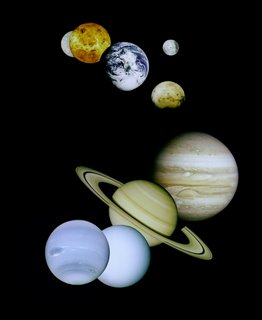Friday, May 26, 2006
Thursday, May 25, 2006
Wednesday, May 24, 2006
Tuesday, May 23, 2006
Sunday, May 21, 2006
Saturday, May 20, 2006
Jupiter's moons
Cresent Europa
Dimensions: 700x700
Size: 66.7 KB
Credit: NASA
~~~~~~~~~~~~~~~~~~~~
This is Jupiter's moon Europa. Picture is taken by Voyager 2. Surface of this moon in ice (bright areas) and rock (darkened areas).
~~~~~~~~~~~~~~~~~~~~~~~~~~~~~~~~~
Io

Dimensions: 600x600
Size: 85.3 KB
Credit: NASA
~~~~~~~~~~~~~~~~~~~~
Io is Jupiter's moon. This photo is taken on July 3, 1999.
Dimensions: 700x700
Size: 66.7 KB
Credit: NASA
~~~~~~~~~~~~~~~~~~~~
This is Jupiter's moon Europa. Picture is taken by Voyager 2. Surface of this moon in ice (bright areas) and rock (darkened areas).
~~~~~~~~~~~~~~~~~~~~~~~~~~~~~~~~~
Io

Dimensions: 600x600
Size: 85.3 KB
Credit: NASA
~~~~~~~~~~~~~~~~~~~~
Io is Jupiter's moon. This photo is taken on July 3, 1999.
Tadpole's Tidal Tail
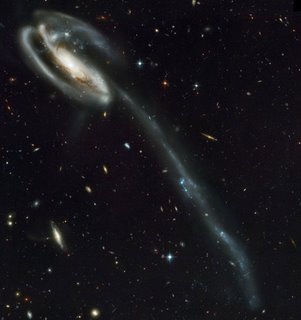
This image is tak with the Hubble Telescope. It shows far galaxies and spiral galaxy Arp 188 better known as Tadpole Galaxy. It is 420 million light-years distant toward the northern constellation Draco. It's tail is about 280 thousand light-years long.
Tadpole Galaxy will lose it tail as it grows older.
Thursday, May 11, 2006
The Da Vinci Glow

Da Vinci isn’t just Mona Lisa. Da Vinci discovered Earthshine…
Leonardo explained “ashen glow” or "the old Moon in the new Moon's arms” how humans called this apperance for thousands of years. Up to 16th century noone knew how to explain this, until Da Vinci figured it out
The source of Earthshine are clouds. Oceans are also source of Earthshine but not the primary. Earth is shining because it reflects sunlight. Clouds are the first who do reflecting. Interesting is that when Apollo astronauts looked at Earth, the clouds were bright and the oceans were dark.
Sunday, May 07, 2006
Solar minimum
How to prove that Sun spins?
It is really simply.
Step 1: Look at the sun. You can use internet to look at the sun.
Step 2: Sketch the sunspots
Step 3: Do step 2 daily. After few days you will see that sunspots are moving. One complete turn sun perform every 27 days.

A picture of the sun taken Feb. 10, 2006, by the Solar and Heliospheric Observatory (SOHO).
This is how Galileo prove that sun spins in 1610.
In this time it is not possible to prove that sun spins! There are no sunspots. For almost entire February 2006 the sun was blank. If Galileo look at the sun now he would have been disappointed. There are no sunspots, no spin, no discovery.
What is all this? David Hathaway (NASA solar Physicist) explains: “solar minimum has arrived.”
Every 11 year sunspots came and go. This is sunspot cycle. At sunspots maximum there are spots big as Jupiter, and in sunspots minimum period there is no single spot.
This year is minimum so there are no sptos on sun.
No sunspots means low solar activity.
Galileo look at sin in 1610. and that year was close to to a maximum sunspot cycle. He was lucky. Also Chinese astronomers had reported spots on sun in 28 BC. The nature of spots in mystery. Maybe they are satellites, dark clouds or something else.

A sketch of the sun made by Galileo in June 1613.
It is really simply.
Step 1: Look at the sun. You can use internet to look at the sun.
Step 2: Sketch the sunspots
Step 3: Do step 2 daily. After few days you will see that sunspots are moving. One complete turn sun perform every 27 days.

This is how Galileo prove that sun spins in 1610.
In this time it is not possible to prove that sun spins! There are no sunspots. For almost entire February 2006 the sun was blank. If Galileo look at the sun now he would have been disappointed. There are no sunspots, no spin, no discovery.
What is all this? David Hathaway (NASA solar Physicist) explains: “solar minimum has arrived.”
Every 11 year sunspots came and go. This is sunspot cycle. At sunspots maximum there are spots big as Jupiter, and in sunspots minimum period there is no single spot.
This year is minimum so there are no sptos on sun.
No sunspots means low solar activity.
Galileo look at sin in 1610. and that year was close to to a maximum sunspot cycle. He was lucky. Also Chinese astronomers had reported spots on sun in 28 BC. The nature of spots in mystery. Maybe they are satellites, dark clouds or something else.

Saturday, May 06, 2006
Planet Named George
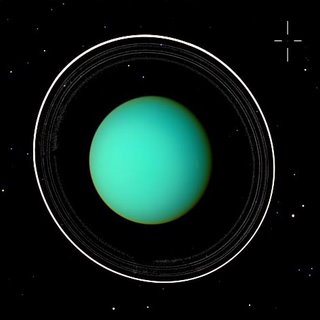
Ancient people have spent countless hours watching Mercury, Venus, Mars, Jupiter and Saturn. Can you belive they missed one!
There is and sixth planet you can see without telescope, a planet named George!
“George” is glowing like an aqua-blue star of 6th magnitude. It is four times bigger than Earth, it has more than 30 moon and dozen thin rings. George make one full spin around Earth in 84 years.
George is better known as Uranus.
William Herschel, English astronomer, discovered “George” in 1781. He named it the Georgium Sidus (the Georgian Planet) in honor of his king, King George III. Later George was re-named Uranus, like the Greek god of sky.
Uranus had been mistaken many times for a star. John Flamsteed (astronomer) cataloged it as 34 Tauri, the 34th star of Taurus the Bull. Uranus is too far from the sun and it looks like a star without using telescope. Also Uranus moves so slowly.
Friday, May 05, 2006
Thursday, May 04, 2006
Saturn's Subtle Spectrum
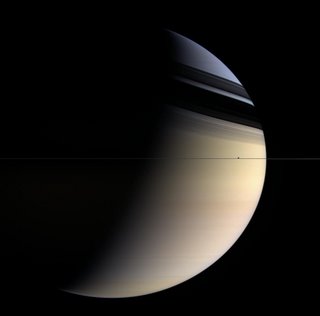 Dreamy colors ranging from pale rose to butterscotch to sapphire give this utterly inhospitable gas planet a romantic appeal. Shadows of the rings caress the northern latitudes whose blue color is presumed to be a seasonal effect. Enceladus (505 kilometers, or 314 miles across) hugs the ringplane right of center. Image Credit: NASA/JPL/Space Science Institute
Dreamy colors ranging from pale rose to butterscotch to sapphire give this utterly inhospitable gas planet a romantic appeal. Shadows of the rings caress the northern latitudes whose blue color is presumed to be a seasonal effect. Enceladus (505 kilometers, or 314 miles across) hugs the ringplane right of center. Image Credit: NASA/JPL/Space Science Institute
Lunar Dust Buster
Lunar Dust Buster
Ever get a fragile item packed in a box filled with Styrofoam peanuts? Plunge your hands into the foam peanuts to search for the item, and when you pull it out foam peanuts are clinging to your arms. Try to brush them off, and they won't fall off—instead, they seem to hop away, only to cling to your legs or elsewhere. The smaller the peanuts, the more tenacious they seem. In fact, if you break a foam peanut into bits, the tiny lightweight bits are almost impossible to brush off. This behavior is classic static cling. It's also the behavior of lunar—and possibly also Martian—dust. The dozen Apollo astronauts who landed on the Moon between 1969 and 1972 found moondust to be an unexpected challenge. Not only was it so abrasive that it wore partially through the outer gloves of their space suits, but also it stuck to everything. The more they tried to brush it away, the more it worked its way into the space suits' fabric.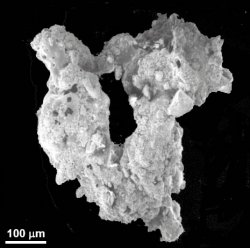
Part of the dust's tenacious clinging was due to the sharp, irregular shapes of individual dust grains, formed by millions of years of meteorite impacts that repeatedly melted rocks into glass and then broke the glassy rocks into powdered glass. The particles' jagged edges were almost like claws that hooked into things like microscopic burrs. But another reason was the dust's electrostatic charge. On the Moon, harsh, unshielded ultraviolet rays from the Sun have enough energy to kick electrons out of the upper layers of the regolith (soil), giving the surface of each dust particle a net positive charge. The smaller the particles, the less their mass and the greater their charged surface area, so the more they clung—just like Styrofoam peanuts broken into small bits. A team led by Carlos I. Calle (lead scientist at NASA's Electrostatics and Surface Physics Laboratory at Kennedy Space Center), however, has used a bit of intellectual judo to figure out a way to take advantage of the dust grains' electrostatic charge to repel them. In fact, they've come up with a new application of an old idea. "In the 1970s, electrical engineering professor Senichi Masuda of the University of Tokyo—well-known as a pioneer in electrostatics—came up with the 'electric curtain'," Calle recalls. Masuda, not even thinking about the Moon or Mars, was working on air pollution filters. Because smog particles are often charged, Masuda came up with a prototype of what he called the electric curtain. Essentially, the electric curtain was a series of parallel electrodes—thin copper wires—spaced roughly a centimeter (half an inch) apart in a circuit board. To them, Masuda applied alternating current, such as that from an ordinary wall socket. The word "alternating" refers to the fact that the electrons in the wires are quickly—60 times a second in the United States, 50 times a second in Europe—made to move forward and backward along the wire, instead of just in one direction as in the direct current from a battery.
 Calle's device rapidly throws off simulated martian dust in a laboratory test at the Kennedy Space Center.
Calle's device rapidly throws off simulated martian dust in a laboratory test at the Kennedy Space Center.
Ever get a fragile item packed in a box filled with Styrofoam peanuts? Plunge your hands into the foam peanuts to search for the item, and when you pull it out foam peanuts are clinging to your arms. Try to brush them off, and they won't fall off—instead, they seem to hop away, only to cling to your legs or elsewhere. The smaller the peanuts, the more tenacious they seem. In fact, if you break a foam peanut into bits, the tiny lightweight bits are almost impossible to brush off. This behavior is classic static cling. It's also the behavior of lunar—and possibly also Martian—dust. The dozen Apollo astronauts who landed on the Moon between 1969 and 1972 found moondust to be an unexpected challenge. Not only was it so abrasive that it wore partially through the outer gloves of their space suits, but also it stuck to everything. The more they tried to brush it away, the more it worked its way into the space suits' fabric.

A tiny, jagged speck of moondust. Micro-photograph courtesy of David McKay, NASA/JSC.
Part of the dust's tenacious clinging was due to the sharp, irregular shapes of individual dust grains, formed by millions of years of meteorite impacts that repeatedly melted rocks into glass and then broke the glassy rocks into powdered glass. The particles' jagged edges were almost like claws that hooked into things like microscopic burrs. But another reason was the dust's electrostatic charge. On the Moon, harsh, unshielded ultraviolet rays from the Sun have enough energy to kick electrons out of the upper layers of the regolith (soil), giving the surface of each dust particle a net positive charge. The smaller the particles, the less their mass and the greater their charged surface area, so the more they clung—just like Styrofoam peanuts broken into small bits. A team led by Carlos I. Calle (lead scientist at NASA's Electrostatics and Surface Physics Laboratory at Kennedy Space Center), however, has used a bit of intellectual judo to figure out a way to take advantage of the dust grains' electrostatic charge to repel them. In fact, they've come up with a new application of an old idea. "In the 1970s, electrical engineering professor Senichi Masuda of the University of Tokyo—well-known as a pioneer in electrostatics—came up with the 'electric curtain'," Calle recalls. Masuda, not even thinking about the Moon or Mars, was working on air pollution filters. Because smog particles are often charged, Masuda came up with a prototype of what he called the electric curtain. Essentially, the electric curtain was a series of parallel electrodes—thin copper wires—spaced roughly a centimeter (half an inch) apart in a circuit board. To them, Masuda applied alternating current, such as that from an ordinary wall socket. The word "alternating" refers to the fact that the electrons in the wires are quickly—60 times a second in the United States, 50 times a second in Europe—made to move forward and backward along the wire, instead of just in one direction as in the direct current from a battery.

Prof. Senichi Masuda's diagram of the original "electric curtain," circa 1971.
But instead of providing the same alternating current to all the parallel electrodes at once, Masuda did something ingenious. He slightly delayed the onset of the current to each successive electrode. That slight delay made the electromagnetic field of each electrode to be out of phase with its neighbors, creating an electromagnetic wave that rapidly traveled horizontally across the surface on which the electrodes lay. Moreover, any charged particles lying on the surface got lifted and moved by that traveling electromagnetic wave, as if they were surfers being pushed along by an ocean wave. Fast forward to the present: After seeing how Martian dust that collected on the solar panels of Mars Pathfinder deprived it of electric power and impaired performance, Calle and his collaborators began wondering if the electric curtain could be adapted to keep solar panels on the Moon and Mars dust-free. After all, he reasoned, "human and robot astronauts can't always be cleaning windows." To let sunlight through, however, the device would need transparent electrodes. So instead of using copper wires, Calle and his colleagues made electrodes out of indium titanium oxide (ITO), transparent semiconducting oxides "that are now a mature technology, used in the touch screens of PDAs (personal digital assistants)," Calle explains. They also moved the electrodes closer together—just a few millimeters apart. The result was a transparent film that "is flexible, like a sheet of vinyl," that they call an electrodynamic dust shield.
 Calle's device rapidly throws off simulated martian dust in a laboratory test at the Kennedy Space Center.
Calle's device rapidly throws off simulated martian dust in a laboratory test at the Kennedy Space Center.When the transparent dust shield was covered with simulated lunar or Martian dust (which is mostly ground-up volcanic ash and cinders from terrestrial volcanoes) and put in a vacuum chamber that was then pumped down to the rarefied atmospheric pressure of Mars or the Moon, it worked like a champ. Most of the dust was thrown off to the side in seconds. None of the simulated lunar and Martian soils, however, contains either the pure iron or shards of glass found in real moondust. This difference might affect the dust shield's effectiveness. "I'm hoping to try the experiment again with a vial of actual lunar dust," he says. While Calle is optimistic about the dust shield's effectiveness for large flat or gently curved surfaces such as solar panels and the visors of astronauts' helmets, "folds in the fabric of a space suit are more challenging," he says. "ITOs are flexible, but after a point will break." He's also working to fine-tune the voltage, frequency, phase, and other electrical properties of the traveling electromagnetic wave to repel the greatest amount of dust. And he's curious to see how it would behave in lower gravity. There's much work to be done, says Calle, but one day his device might draw the curtain on the troubles with moondust.





